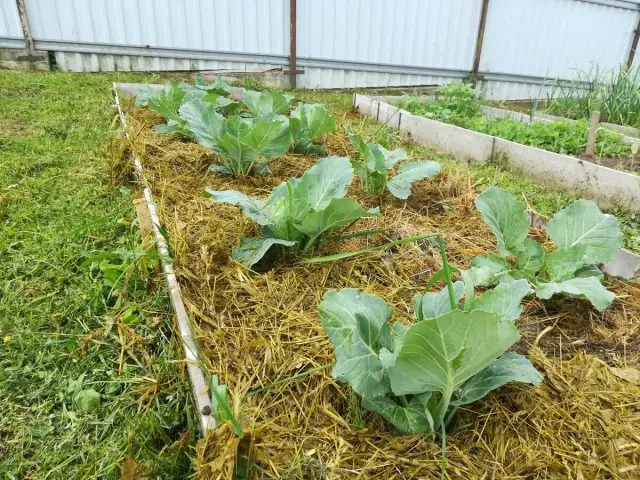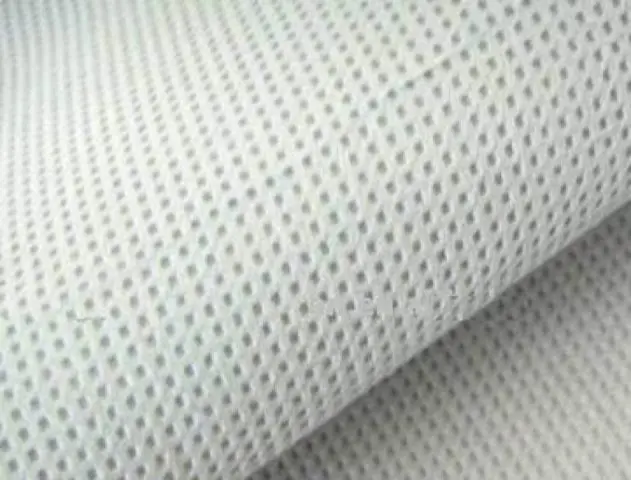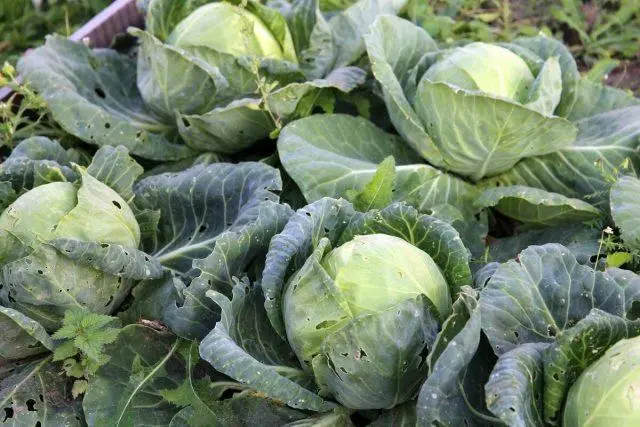Contents
You can mulch cabbage with different materials. Basically, sawdust, peat, straw, wood chips, needles, hay and other organic matter are used for these purposes. It serves not only as a covering material, but also as a fertilizer, as well as a means of preventing weeds and pests. Mulch is laid out immediately after planting in open ground and, if necessary, changed 2-3 times per season.
Is it necessary to mulch cabbage in the open field
Mulching is a common agricultural technique, which consists in creating a protective layer on the soil surface with a height of 5 to 10 cm (it can be even higher when it comes to shelter for the winter). Mulching mimics forest litter, which is often found in wildlife. As practice shows, it is necessary to lay protective material for almost any plant, including cabbage.
If you mulch planting, it gives several advantages at once:
- The soil retains moisture longer, so cabbage can be watered less often, which is especially true for regions with hot summers.
- The soil retains a loose structure longer, due to which oxygen freely flows to the roots, and the cabbage grows better.
- The root system is protected both from overheating and from short-term frosts, temperature changes.
- You need to mulch with natural materials, they gradually rot and serve as natural fertilizer.
- Certain types of mulch for cabbage (needles, sawdust) repel rodents.
- Mulching your plantings will stop the growth of weeds.
- The lower part of the stem and leaves are protected from decay.
- Mulch helps to regulate the acidity (pH) of the soil.
Thus, if you mulch cabbage, you can achieve several goals at once. This technique increases the natural fertility of the soil and also facilitates maintenance. It is especially important to lay out a protective layer in open ground, because, unlike a greenhouse, it is more difficult to deal with temperature changes and other adverse weather factors here.

Thanks to mulching, caring for cabbage becomes much easier.
Terms of work
Mulching cabbage is recommended throughout the season. During this time, the material is changed 2-3 times (as needed). Main steps:
- In the spring, after transplanting seedlings into open ground, they should be immediately mulched to protect them from possible frosts. For this, black synthetic materials are usually used. They keep the soil warm and prevent weeds from germinating.
- In summer – during this period the drought begins. Therefore, mulching cabbage is worth it to maintain soil moisture. Use natural materials such as hay, straw or sawdust. Synthetic fabric is also allowed.
- In autumn, it is no longer necessary to mulch the plantings – by this time the crop is harvested. It remains only to remove all plant residues and discard. It is not worth using them for fertilizer, as this can lead to the transmission of infection, the appearance of insects next spring.
Preparation of beds
Before mulching cabbage, you need to prepare the beds. It is recommended to start work in early April or on the eve of autumn. The site is cleaned, the soil is dug up and compost or humus is added at 8-10 kg per square meter. Instead, you can use a complex fertilizer of 50 g for the same area.
If the soil is dense, contains a lot of clay, sawdust or sand is covered in an amount of 3-4 kg for the same area. Then beds are formed, several holes are marked and seedlings are transplanted into open ground. Next, planting cabbage should be mulched with straw, peat, sawdust.
How to mulch cabbage in the open field
For the procedure, you can choose a variety of materials – almost all of them are available at home and cost nothing. Most often used hay, straw, sawdust. You can also mow the grass or lay peat, compost. The main types of mulch, their features, pros and cons are described in the following sections.
Hay and straw
Hay is one of the best covering materials that can be used to mulch a variety of crops, including cabbage. Hay and straw can be harvested on your own or purchased at an affordable price. Mulch the cabbage in a fairly small layer 5 cm high.
The material well protects the soil from night frosts, allows air to pass through, preserves moisture, inhibits the growth of weeds, keeps dryness and prevents rotting of the lower leaves. But for the winter after harvesting cabbage, you should not use straw, because rodents can winter in it.

Hay is recommended for use in the summer
Mowed grass
Mowed grass is also enough just to mulch the cabbage. You can get the material in any garden – just remove the grass with a lawn mower or manually (weeding). This can be done at any phase before the formation of seeds (after flowering it is better not to risk it). Moreover, it is better to prepare the grass back in May or June, because then it can rot, provoke the appearance of a fungal infection.
The cut grass can be chopped a little and laid out to dry under the sun. Or immediately put on the beds, including in the aisle, where it also dries pretty quickly. Mulching cabbage is allowed both in spring and summer.
Eggshell
The shell is used mainly as a fertilizer (a source of calcium), and if there is a lot of it, then as a covering material. It is laid out in a small layer, and then covered, for example, with hay or straw.
To do this, nutshells, mustard powder and red ground pepper will help.
sawdust, chips
Sawdust and small chips can mulch cabbage and other plantings. These are affordable and high-quality materials that are used for shelter, pest repellent and as fertilizer. First, they are dried for several days in the open air, then a low layer is formed.
Decomposed sawdust can be dug into the soil, which is especially useful for dense clay soils. If the environment is acidic, pH less than 5, you should not often use wood chips and sawdust. Otherwise, it will become even more sour. To avoid this, it is recommended to add wood ash (100-200 g per square meter) or dolomite flour (150 g).

Overheating, sawdust enriches the soil with nitrogen
Peat and compost
Peat and compost is one of the common materials that can be used to mulch cabbages and other crops. These are organic fertilizers that enrich the soil with all the main elements. In addition, they repel pests well. The advantage of peat and compost is that there is no need to remove materials. On the contrary, after rotting, they are left in the garden. If the soil is infertile, it is recommended to add peat and compost even at the stage of digging (up to a total of 10 kg per square meter).
Manure
Cabbage can also be mulched with manure, but if it is fresh, it is planted only in the fall, when the last crop has been harvested. It is categorically impossible to use fresh material for planting – due to the high concentration of chemicals, the roots will burn out, most of the plantings will die.
During digging, manure is brought directly into the soil up to 8 kg per square meter. Then you need to wait at least five months, and then proceed to planting. For mulching, it is allowed to use already rotted manure. To do this, he is allowed to lie down in a heap for six months or more (periodically watered). It is also worth adding leaves, straw, plant residues and peat to it (in total for 2/3 of the volume).
inorganic mulch
Mulching cabbage is also allowed with inorganic materials. The most budget option is a transparent or black plastic film. Dark material is laid out on the garden bed 3-4 weeks before planting. This is to prevent the growth of weeds.
A transparent film is put in the summer. It should make several holes for free access of air. Then spread along the aisles and fixed with stones. The material is very cheap, but short-lived – it will have to be changed every 2-3 weeks.
Nonwovens
You can also mulch cabbage with special non-woven materials. They are more expensive than plastic film, but they are more durable and breathable. The most commonly used non-woven fabrics are:
- lutrasil;
- agrospan;
- spunbond;
- spanbel.

Lutrasil and other canvases serve for 3-4 years
Along with different types of agrofibre, small stones and expanded clay can also be used. The disadvantage is that because of them it is quite difficult to water the soil, to carry out loosening. Therefore, it is best to lay stones at the bottom of the landing holes.
You can also mulch cabbage with ordinary cardboard. This is a temporary option in case other materials are not available. After rain, it gets wet pretty quickly. Burlap is also suitable – it does not allow the soil to erode, which is especially important in the lowlands.
How to choose cabbage mulching material
You can mulch cabbage with almost any material. In this case, several criteria must be taken into account:
- Durability.
- The ability to pass air.
- Possibility to use as a fertilizer.
- Affordability.
It is best to use natural mulches such as hay, straw and sawdust. It serves as a shelter and pest control, and also works as a fertilizer. But if you choose for durability, it is recommended to mulch plantings with agrofiber and other non-woven fabrics.
Do I need to mulch the greenhouse
Along with mulching cabbage in the open field, laying out a covering layer is also recommended when growing in a greenhouse, especially if it is unheated. Humidity levels are almost always higher indoors than outdoors. Therefore, the use of artificial materials, such as plastic wrap, is not worth it.
Organics are best suited – peat, compost, hay, sawdust, straw, needles. You can lay it in a small layer, mulching cabbage and other plants. First you need to wait until the greenhouse warms up. If the greenhouse is heated, you can mulch at any time.
In this case, the layer must be changed at least three times per season, since organic matter will quickly rot (peat and compost can be left). For the winter, all plant debris is removed along with the mulch. Fungal spores, insect larvae overwinter in them, and rodents can hide. At the same time, the greenhouse is treated with potassium permanganate or another antiseptic. If diseases or pest infestations have been observed, the soil should also be disinfected.

Mulching helps increase crop yields
Conclusion
Mulching cabbage is desirable, especially when grown outdoors. The material will protect the soil from overheating, night frosts, and also from rapid drying. In addition, decomposing, straw, peat and other substances serve as natural fertilizer. Thanks to this, cabbage care becomes easier, and the yield increases.









